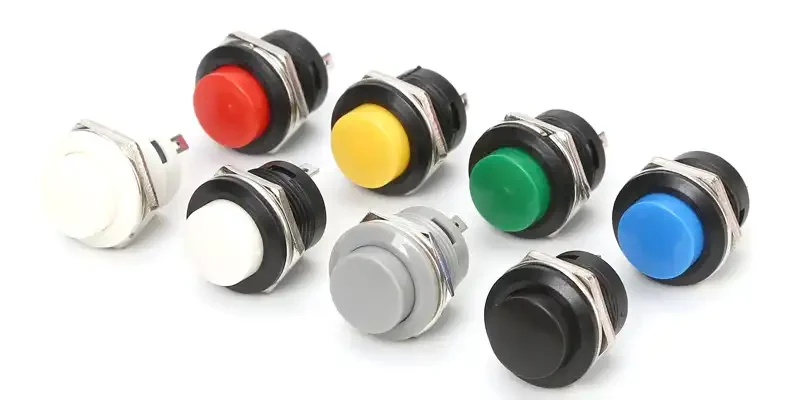Co to jest przełącznik przyciskowy?
Przełącznik przyciskowy to wszechstronne urządzenie elektryczne, które kontroluje przepływ prądu w obwodach za pomocą prostego naciśnięcia. Powszechne w domach, miejscach pracy i różnych środowiskach, przełączniki te są kluczowymi elementami nowoczesnej elektroniki i systemów mechanicznych. Zazwyczaj wykonane z tworzywa sztucznego lub metalu, przyciski mogą być płaskie lub ergonomicznie ukształtowane dla łatwego użytkowania. Po naciśnięciu zamykają obwód, umożliwiając przepływ prądu. Przełączniki przyciskowe występują w różnych typach, w tym w wersjach chwilowych, zatrzaskowych i podświetlanych, z których każda pełni inne funkcje. Działają przy użyciu podstawowego mechanizmu elektrycznego lub pneumatycznego i mogą być chwilowe lub zatrzaskowe. Przełączniki te są niezbędne do wydajnego sterowania w zastosowaniach od urządzeń gospodarstwa domowego po złożone maszyny przemysłowe, oferując intuicyjny i niezawodny sposób aktywacji lub dezaktywacji funkcji.
Struktura przełącznika przyciskowego
Przełącznik przyciskowy zasadniczo składa się z nasadki przycisku, sprężyny powrotnej, styku ruchomego typu mostkowego, styku statycznego, pręta łączącego kolumny i obudowy.
Zasada działania
- Uruchamianie: Naciśnięcie przycisku powoduje uruchomienie wewnętrznego mechanizmu, który zazwyczaj składa się ze sprężyny i styków elektrycznych. Nacisk wywierany na przycisk ściska sprężynę i przesuwa wewnętrzne styki do pozycji, w której łączą się lub rozłączają, w zależności od typu przełącznika.
- Typy kontaktów:
- Normalnie otwarty (NO): W tej konfiguracji obwód jest otwarty, gdy przycisk nie jest naciśnięty. Naciśnięcie przycisku zamyka obwód, umożliwiając przepływ prądu. Jest to powszechne w aplikacjach takich jak dzwonki do drzwi i przełączniki chwilowe.
- Normalnie zamknięty (NC): W tym przypadku obwód jest zamknięty, gdy przycisk nie jest naciśnięty. Naciśnięcie przycisku otwiera obwód, przerywając przepływ prądu. Ten typ jest często używany w aplikacjach bezpieczeństwa, takich jak przyciski zatrzymania awaryjnego.
- Mechanizm powrotny: Po zwolnieniu przycisku mechanizm sprężynowy przywraca go do pierwotnej pozycji. To działanie przywraca obwód do poprzedniego stanu - otwartego lub zamkniętego - w zależności od tego, czy był to przełącznik NO czy NC.
Zobacz film o tym, jak działa przycisk
Typy przełączników przyciskowych
Przełączniki przyciskowe są dostępne w różnych typach, podzielonych na kategorie w oparciu o różne cechy:
Typy oparte na kształcie:
- Kwadratowe: Przełączniki te posiadają duży przycisk lub siłownik w kształcie kwadratu. Ich duża powierzchnia sprawia, że są popularne w zastosowaniach przemysłowych.
- Okrągłe: Okrągłe przełączniki przyciskowe, charakteryzujące się okrągłym kształtem i kompaktowymi rozmiarami, są powszechnie stosowane w urządzeniach gospodarstwa domowego i elektronice użytkowej ze względu na ich ergonomiczną konstrukcję i trwałość.
Typy oparte na konfiguracji:
- SPST (Single Pole Single Throw): Najpopularniejszy typ, z jednym biegunem i jednym przełącznikiem. Przełączniki te są zwykle używane do odłączania lub ponownego podłączania pojedynczego przewodu w pojedynczym obwodzie odgałęzionym.
- SPDT (Single Pole Double Throw): Przełączniki te mają jeden biegun i dwa wyjścia lub zaciski wyjściowe, umożliwiając sterowanie wieloma obwodami poprzez wybór jednego z dwóch stanów wyjściowych.
Typy oparte na funkcjonalności:
- Przełączniki chwilowe: Pozostają aktywne tylko wtedy, gdy siłownik jest wciśnięty. Po zwolnieniu obwód zostaje przerwany, przerywając przepływ prądu. Typowymi przykładami są dzwonki do drzwi i brzęczyki.
- Przełączniki zatrzaskowe: Przełączniki te utrzymują swoją pozycję po naciśnięciu aż do ponownej aktywacji. Jednokrotne naciśnięcie przycisku zmienia stan przełącznika, który pozostaje do momentu ponownego naciśnięcia. Typowy włącznik i wyłącznik w domach jest przykładem tego typu.
Napięcie znamionowe przełącznika przyciskowego
Przełączniki przyciskowe są dostępne w różnych napięciach znamionowych, co ma kluczowe znaczenie dla ich przydatności w różnych zastosowaniach. Zrozumienie tych wartości znamionowych jest niezbędne do prawidłowego wyboru i bezpiecznej obsługi.
Wspólne wartości znamionowe napięcia:
- Niskie napięcie: Wiele przełączników jest przystosowanych do pracy z napięciem do 32 VDC, co czyni je idealnymi do zastosowań niskonapięciowych.
- Standardowy zakres: Typowe wartości znamionowe wynoszą od 12 VDC do 250 VAC, w zależności od konstrukcji i zastosowania.
- Konkretne przykłady: Niektóre przełączniki chwilowe obsługują 5 mA przy 32 VDC, podczas gdy inne są przystosowane do 3 A przy 125 VAC lub 1,5 A przy 250 VAC.
Rozważania dotyczące prądu przemiennego i stałego:
- Różne wartości znamionowe: Przełączniki AC i DC często mają różne wartości znamionowe napięcia ze względu na różne charakterystyki przepływu prądu.
- Kompatybilność obwodów: Kluczowe znaczenie ma wybór przełącznika przeznaczonego do obwodów AC lub DC zgodnie z zastosowaniem.
Obciążenie i czynniki środowiskowe:
- Typ obciążenia: Obciążenia rezystancyjne i indukcyjne mają różny wpływ na wartości znamionowe napięcia. Obciążenia indukcyjne mogą wymagać przełączników o wyższym prądzie rozruchowym.
- Ochrona środowiska: Niektóre przełączniki mają dodatkowe klasy (np. IP67) odporności na kurz i wodę, co ma kluczowe znaczenie w przypadku zastosowań zewnętrznych lub przemysłowych.
Wytyczne dotyczące wyboru:
- Specyfikacje producenta: Dokładne wartości znamionowe napięcia i prądu należy zawsze sprawdzać w arkuszu danych producenta.
- Zależnie od zastosowania: Należy wziąć pod uwagę zamierzone zastosowanie, ponieważ wartości znamionowe mogą się znacznie różnić między modelami miniaturowymi i przemysłowymi.
Jak wybrać przełącznik przyciskowy?
Przełączniki przyciskowe to wszechstronne komponenty, które wymagają odpowiedniego zrozumienia w celu efektywnego użytkowania i konserwacji. Aby prawidłowo z nich korzystać, należy zidentyfikować typ przełącznika (chwilowy lub zatrzaskowy) i zainstalować go zgodnie ze specyfikacjami producenta, zapewniając odpowiednie okablowanie i dopasowanie napięcia znamionowego. Używaj przełącznika zgodnie z przeznaczeniem, z ciągłym naciskiem w przypadku przełączników chwilowych lub pojedynczymi naciśnięciami w przypadku przełączników zatrzaskowych.
Jak używać i konserwować przełączniki przyciskowe?
W celu konserwacji należy regularnie czyścić powierzchnię przełącznika, sprawdzać połączenia elektryczne i sprawdzać pod kątem uszkodzeń fizycznych. Należy okresowo testować funkcjonalność i brać pod uwagę czynniki środowiskowe, które mogą wpływać na wydajność. W razie potrzeby wymieniaj komponenty lub cały przełącznik i zawsze miej pod ręką dokumentację. Postępując zgodnie z tymi wytycznymi, użytkownicy mogą zapewnić optymalną wydajność i długowieczność swoich przełączników przyciskowych w różnych zastosowaniach.
Producenci przycisków
| Nazwa firmy | Rok założenia | Kraj | WEB |
|---|---|---|---|
| Schneider Electric | 1836 | Francja | Schneider.com |
| Electro-Mech Components, Inc. (EMC) | 1966 | USA | electromechcomp.com |
| Przełączniki i przekaźniki zasilania Electroswitch | 1946 | USA | Electroswitch.com |
| OMRON Corporation | 1933 | Japonia | OMRON.com |
| CHINT | 1994 | Chiny | Chint.com |
| ABB Limited | 1883 | Szwajcaria | ABB.com |
| Eaton Corporation Inc. | 1911 | USA | Eaton.com |
| Toshiba Corporation | 1875 | Japonia | Toshiba.com |




